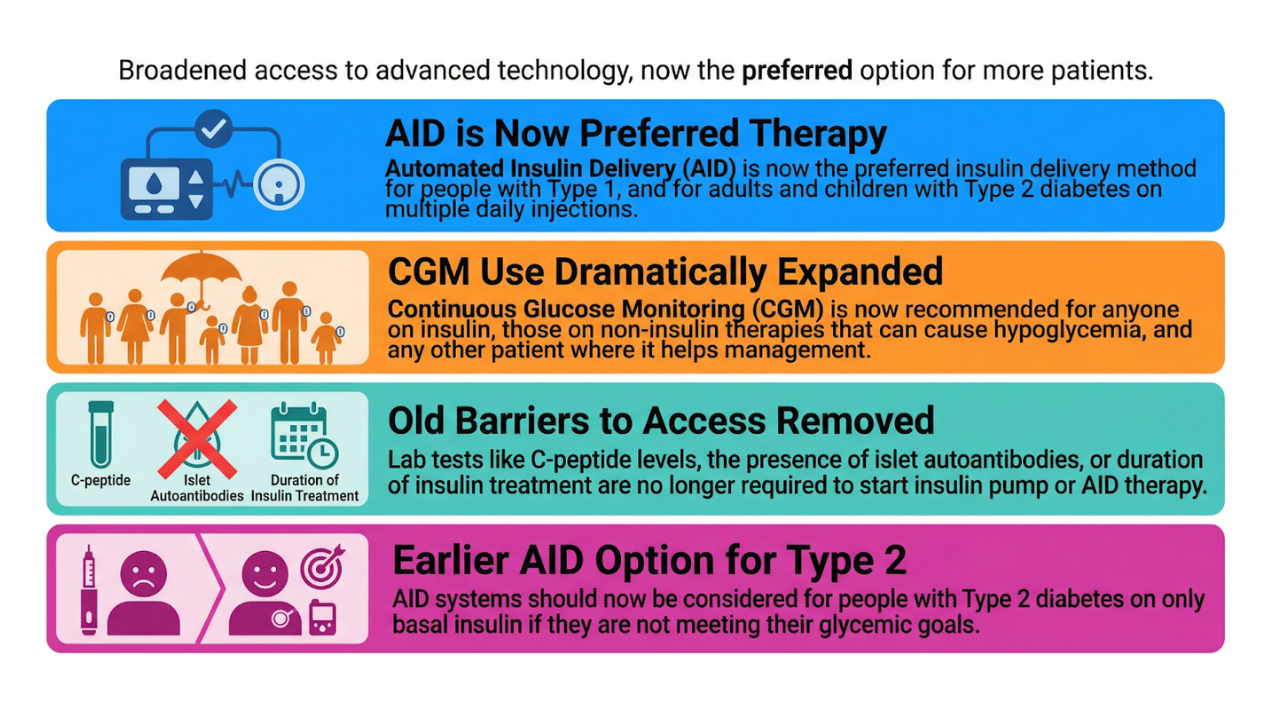Breaking Down the ADA’s 2025 Diabetes Tech Guidelines
Dec 23, 2024
This podcast is created by NotebookLM based on this blogpost and the updated ADA Standards of Care 2025, focused on diabetes technology.
On December 9, 2024, the American Diabetes Association (ADA) released its Standards of Care 2025, featuring updates that reflect the latest evidence in diabetes care.
These annual updates, in place since 1989, are developed by the ADA Professional Practice Committee and continue to provide guidance to improve diabetes management.
This year, the updates expand recommendations for Continuous Glucose Monitors (CGMs) to more diabetes populations & introduce Automated Insulin Delivery (AID) systems for new use cases, including type 2 diabetes.
Let’s explore the detailed updates while celebrating their implications for a hopeful and innovative 2025.
Get Access To Updated Diabetes Technology Courses
The Purpose of the ADA Guidelines
The Standards of Care serve a diverse audience:
-
Healthcare teams: Endocrinologists, primary care physicians, nurse practitioners, pharmacists, registered dietitians, and diabetes educators.
-
Policy stakeholders: Payors, policymakers, researchers, and advocacy groups.
-
People with diabetes and caregivers: Empowering shared decision-making with their care providers.
These recommendations aim to ensure the best outcomes through evidence-based, patient-centered diabetes care.
As a reminder, here is an overview of the evidence levels used in the ADA Guidelines:
-
Level A: Clear or supporting evidence from well-conducted, generalizable randomized controlled trials that are adequately powered.
-
Level B: Supportive evidence from well-conducted cohort studies or a well-conducted case-control study.
-
Level C: Supportive evidence from poorly controlled or uncontrolled studies, or conflicting evidence with the weight of evidence supporting the recommendation.
-
Level E: Expert consensus or clinical experience.
Key Updates on Diabetes Technology
Recommendations for CGM Use

#1 CGM for All People on Insulin

This UPDATED recommendation makes it clear that CGM is recommended for all people with diabetes who are on any type of insulin, including youth on basal-only insulin.
Prior guidelines already included adults on any type of insulin and youth on intensive insulin therapy, so this update reflects another step towards universal inclusion.
However, while CGM is recommended for all insulin users, access and affordability remain significant challenges in many parts of the world.
#2 CGM for Adults with Type 2 Diabetes Without Insulin

This NEW recommendation introduces CGM use for all adults with type 2 diabetes to achieve glycemic goals, reflecting the growing evidence of CGM’s benefits beyond insulin users.
#3 CGM for Diabetes during Pregnancy

This UPDATED recommendation highlights the benefits of CGM for achieving glycemic goals during pregnancy and eliminates the prior need for adjunctive blood glucose monitoring via finger pricks.
Recommendations for AID Systems

#1 Early Introduction of AID Systems

This recommendation is UPDATED as now, not only CGM, but also AID systems are recommended at an early stage in the course of diabetes, even at diagnosis.
#2 Preferred Insulin Delivery for Type 1 and Insulin-Deficient Diabetes

This recommendation reaffirms that AID systems are the preferred insulin delivery method for type 1 diabetes and insulin-deficient diabetes where feasible.
However, while AID systems are recommended for all people with insulin-deficient diabetes, access and affordability remain significant challenges in many parts of the world.
#3 AID Systems for Type 2 Diabetes

This NEW recommendation advocates for offering AID systems to people with type 2 diabetes on multiple daily injections.
Omnipod 5 is the first AID system officially approved for type 2 diabetes. Notably, it even has an FDA-label for individuals with type 2 diabetes on basal-only insulin.
As other AID systems gain broader approval for type 2 diabetes, we anticipate further expansion of these guidelines.
#4 Open-Source AID Systems

This UPDATED recommendation indicates greater openness to open-source AID systems, moving beyond previous limitations that discouraged healthcare professionals from prescribing these systems. The updated guidance emphasizes providing support and diabetes management advice for individuals using open-source closed-loop technology, highlighting the importance of collaborative care.
#5 AID Systems During Pregnancy


These NEW recommendations highlight the safety of AID systems in pregnancy and favor systems with pregnancy-specific targets, such as CamAPS FX and/or mylife Loop.
Diabetes Technology in Hospitals

#1 Personal CGM Use in Hospitals

This recommendation is not new but reinforces the ongoing guidance for continuing CGM use during hospitalization when clinically appropriate, in combination with point-of-care glucose measurements (finger pricks) according to an institutional protocol.
#2 AID Systems in Hospitals Recommendation

This recommendation was UPDATED to emphasize the importance of continuing the use of insulin pumps or AID during hospitalization when clinically appropriate and in combination with point-of-care blood glucose measurements (finger pricks) according to an institutional protocol.
Digital Health Solutions and Coaching

#1 Virtual Coaching and Apps

This NEW recommendation supports the use of digital therapeutics, digital health solutions, and online programs for people with diabetes or prediabetes. Even with limited data, opting into one of these programs can provide helpful support and is an attractive option for many. The guidance was expanded to include the benefits of combining technology with online or virtual coaching to enhance outcomes.
Implications of the 2025 Guidelines

The guidelines underscore the fact that there is now enough evidence to:
-
Recommend (early initiation of) CGM to all people with diabetes on insulin.
-
Consider CGM in people with type 2 diabetes not on insulin to achieve and maintain individualized glycemic goals.
-
Recommend (early initiation of) AID systems to all people with type 1 diabetes and insulin-deficient diabetes.
-
& Offer AID systems to people with type 2 diabetes on multiple daily injections.
The guidelines also provide reassurance regarding:
-
The use of open-source AID systems.
-
The use of CGM and AID systems during hospitalization.
-
& Digital health solutions to support individualized diabetes care.
While these guidelines represent important advancements, it is crucial to note that they do not automatically translate to increased access to CGM and AID systems.
Advocacy and systemic change are essential to bridge the gap between these recommendations and real-world access.
Many parts of the world still face significant barriers, such as unavailability of technology, high costs, or lack of reimbursement systems.
Even though the guidelines do not directly address these access issues,
they can influence policymakers and support recommendations from healthcare providers,
who often serve as key gatekeepers in determining access to diabetes technology.
By raising awareness and driving systemic change, these guidelines can pave the way for broader accessibility in the future.
Join Us in Embracing Innovation
The New Year offers an opportunity to deepen our commitment to advancing diabetes care.
To learn more about CGMs, AID systems, and their practical use, explore our accredited Diabetotech courses.
Start your free 7-day trial today! Click here
Let’s embrace these advancements, inspire hope, and work together for a healthier future.
By staying informed, advocating for broader access, and supporting innovative care solutions, each of us can contribute to making these technologies accessible to more people in need.
Kind regards,





